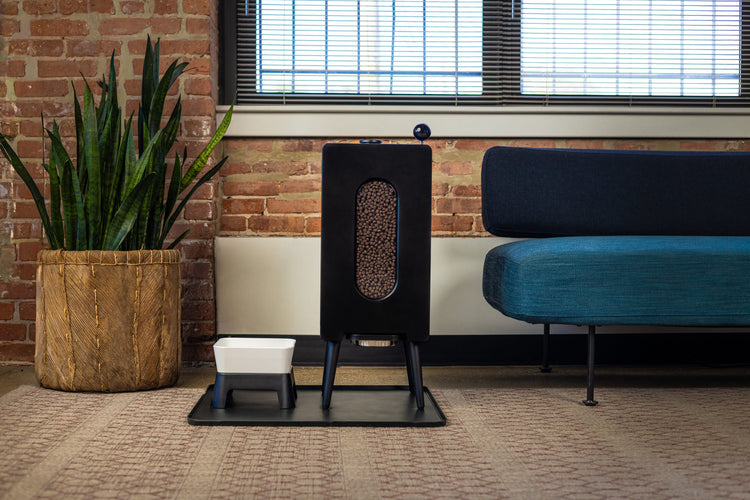Understanding What Is Canned Dog Food and How It Enhances Your Dog’s Life
- Houndsy
Table of Contents
- Introduction
- What Is Canned Dog Food? Breaking Down the Basics
- Benefits of Canned Dog Food: Why Many Dog Owners Choose Wet Meals
- Comparing Canned Dog Food and Dry Kibble: Pros and Cons
- How to Choose Quality Canned Dog Food
- The Role of Feeding Tools in Enhancing the Canned Food Experience
- Frequently Asked Questions (FAQs)
- Conclusion
Introduction
Have you ever wondered why so many dog owners are turning to canned dog food as a go-to meal for their furry friends? Consider this: nearly 40% of U.S. dog owners supplement or fully feed their dogs with wet or canned foods. But what exactly is canned dog food, and how does it compare to the dry kibble you may be using right now?
As pet parents, we understand your desire to provide the best nutrition for your dog while making feeding a seamless part of your everyday routine. At Houndsy, our mission has always been to simplify and elevate the dog feeding experience by blending innovative design with practicality. To do that effectively, it helps to first understand the dietary choices available, starting with “what is canned dog food?”
In this article, we’ll explore the fundamentals of canned dog food—from its composition and benefits to how it fits into your dog’s nutrition and overall well-being. We will unpack the differences between wet and dry diets, provide insights on quality standards, and discuss how feeding habits and product choices intertwine with your lifestyle. Along the way, you'll see how convenience and consistency can come together when you pair nourishing pet food with smart feeding tools like the Houndsy Kibble Dispenser.
So, as you read on, take a moment to consider: How does your current feeding routine support your dog’s health and your home’s flow? Could a fresh approach to dog food and feeding devices enhance both?
Our goal in this post is to provide you with a comprehensive understanding of canned dog food so you can make informed choices that fit your dog’s lifestyle, your home aesthetics, and your time. Let’s unravel what canned dog food really is and why it might just be the next step to elevating your pet care experience.
What Is Canned Dog Food? Breaking Down the Basics
Composition and Processing
Canned dog food—sometimes referred to as wet dog food—is a type of pet food formulated to come in a moist, sealed can or pouch. Unlike dry kibble, which is baked and dehydrated, canned dog food undergoes a distinct preparation process:
- The meat and protein sources are ground to create the core base.
- These proteins are combined with a nutrient-rich gravy or broth, also including vegetables, grains, vitamins, and minerals tailored to your dog’s dietary needs.
- This mixture is cooked and sterilized under pressure in sealed cans to ensure safety, preserve moisture, and extend shelf life.
The final product contains a significantly higher moisture content—often around 75% or more—compared to dry kibble, which typically contains about 10% moisture. This elevated moisture level is one key reason canned dog food can be better suited for specific health and lifestyle needs.
Nutritional Standards and Quality
Just like dry dog food, canned dog food must meet the standards set by organizations such as the Association of American Feed Control Officials (AAFCO). This means manufacturers formulate recipes that are complete and balanced to provide all essential nutrients for your dog’s life stage, whether puppy, adult, or senior.
It’s important to look for products that specify their ingredients clearly and avoid unnecessary fillers, artificial preservatives, or harmful chemicals. Many premium canned foods emphasize natural, whole-food ingredients and avoid grains, common allergens, or synthetics. For example, formulas like those from K9 Natural contain fresh water and high-quality proteins free from artificial fillers and gelling agents, ensuring nutrient density and freshness.
Forms Available
Canned dog food is available in a variety of formats including pâtés, stews, chunks in gravy, and shredded meats. These offer versatility for mixing, topping, or feeding as standalone meals. They come in various can sizes from single servings to larger cans ideal for multi-dog households or extended use.
Benefits of Canned Dog Food: Why Many Dog Owners Choose Wet Meals
Enhanced Hydration and Health
One of the standout benefits of canned dog food is its high moisture content. Dogs don’t always drink enough water on their own, and this dehydration can contribute to urinary tract and kidney problems. Incorporating wet food into your dog’s diet can naturally supplement water intake, helping maintain proper hydration levels.
This makes canned food particularly helpful for dogs with specific medical conditions or for elderly dogs who might have trouble drinking enough water. Enhanced moisture also supports digestion and overall organ function, contributing to your dog’s long-term wellness.
Palatability and Appetite Appeal
The aroma, texture, and flavor profiles of canned dog food strongly appeal to many dogs, especially those who are picky eaters, older dogs with diminished appetite, or dogs recovering from illness. The richer smell and moist texture make the food more enticing, encouraging regular eating habits essential for maintaining energy and health.
Anecdotally, many dog parents notice their pups eagerly approaching meal times when served canned or mixed wet food. This can be a game-changer when managing selective eaters or dogs with dental difficulties.
Satiety and Weight Management
Canned dog food tends to offer greater satiety, meaning dogs feel fuller for longer after mealtimes. This can be a natural way to help control portion sizes and manage weight, especially for dogs prone to over-eating. The moisture and density of wet food contribute to this feeling of fullness.
However, it's essential to monitor feeding amounts carefully to avoid overfeeding, particularly if combining wet and dry foods.
Ease of Chewing and Digestibility
Dogs with dental issues, sensitive gums, or jaw pain often find wet food easier and less painful to consume than dry kibble. This can improve their nutrition uptake and comfort. Additionally, canned food’s softer texture can be more digestible for dogs with certain digestive sensitivities.
Comparing Canned Dog Food and Dry Kibble: Pros and Cons
Understanding what canned dog food is involves recognizing its place alongside dry dog food options. Rather than thinking of them as competitors, each has unique advantages and drawbacks, influencing your pet care decisions.
Canned Dog Food Pros:
- High moisture supports hydration.
- Highly palatable; great for picky or senior dogs.
- Easier to chew, beneficial for dental issues.
- Feels more satisfying, aiding weight management.
- Often contains higher-quality protein and fewer fillers.
Canned Dog Food Cons:
- Typically more expensive per serving than dry food.
- Once opened, leftover food must be refrigerated and used quickly.
- Bulkier storage space required due to cans.
- Feeding can be messier without proper tools.
Dry Kibble Pros:
- Convenient, easy to portion and store.
- Less expensive and longer shelf life once opened.
- Encourages chewing, which helps dental health by reducing tartar build-up.
- Compatible with food puzzles to enrich your dog’s mealtime experience.
Dry Kibble Cons:
- Lower moisture content, less hydration.
- Less palatable for some dogs.
- Could contain more fillers depending on brand quality.
Finding the Best Balance
Many pet experts and veterinarians recommend mixing wet and dry dog food to capture the benefits of both. For example, mixing a scoop of canned food with kibble can enhance taste and hydration while retaining kibble’s convenience and dental benefits.
Whatever you choose, the key lies in maintaining portion control, meeting your dog’s nutritional needs, and making feeding manageable—all while fitting the rhythm of your life.
How to Choose Quality Canned Dog Food
With so many options on the market, selecting excellent canned dog food can feel daunting. Here are crucial factors to consider:
Ingredient Transparency and Quality
Look for brands that list real meat at the top of the ingredient list with minimal additives. Choose products free of artificial flavors, colors, and preservative chemicals. Preferably, the food should be free from fillers like corn, soy, and wheat—common allergens for dogs.
Life Stage and Special Needs
Feeds vary depending on your dog’s age, size, activity level, and health status. Puppies need nutrient-dense formulas rich in protein and calories, while seniors benefit from joint-supporting ingredients and easy-to-chew textures. Dogs with allergies or sensitive stomachs may require grain-free or limited ingredient diets.
Nutritional Completeness
Ensure the product is labeled “complete and balanced” according to AAFCO standards. This indicates it provides all essential nutrients in appropriate ratios.
Packaging and Safety
Cans should be BPA-free and securely sealed to protect food quality. Ready-made sizes that suit your dog’s serving needs can reduce waste and spoilage.
The Role of Feeding Tools in Enhancing the Canned Food Experience
Having great canned dog food is part of the puzzle, but the way you feed your dog daily can make all the difference. At Houndsy, we’ve designed the Houndsy Kibble Dispenser to elevate the feeding ritual by combining style and practicality.
While our dispenser is ideal for dry kibble, the principles it embodies highlight what every pet feeding setup needs: ease, consistency, and beauty. Here’s why thoughtful feeding accessories matter, regardless of food type:
- Perfect Portion Control: Measuring out exact portions can prevent overfeeding and maintain healthy weight.
- Convenience at Standing Height: No more bending or back strain—important if you feed multiple times a day.
- Consistency and Less Mess: Reduces spills, keeps food fresh, and fits beautifully in modern homes.
- Safety Features: Our dispenser’s auto-locking mechanism prevents curious pets or toddlers from accidentally dispensing more food.
Imagine pairing a convenient dispenser with your favorite wet food—using portion scoops or designated bowls—to create a feeding routine that’s efficient and enjoyable for both you and your dog.
If you haven’t yet, explore the Houndsy Kibble Dispenser here to experience how thoughtful design can transform daily dog care into something you look forward to.
Frequently Asked Questions (FAQs)
Is canned dog food good for dogs?
Yes, canned dog food is an excellent source of balanced nutrition with high moisture content, making it especially good for dogs needing hydration support, those with dental issues, or picky eaters. Always choose high-quality brands that meet nutritional standards.
Can I feed my dog canned food every day?
Feeding canned food daily can be perfectly healthy as long as it is complete and balanced and fed in appropriate portions. Some dog parents mix wet and dry food to balance convenience and hydration benefits.
Which canned dog food do dogs like best?
Dogs tend to prefer canned foods with strong natural flavors, real meat, and varied textures like stews or shredded meals. Brands emphasizing natural ingredients, such as K9 Natural, Hill’s Science Diet, and Purina Pro Plan, often rank highly in appeal.
How do I transition my dog to canned food?
Gradually mix canned food into your dog’s current diet over 7-10 days, increasing the portion of wet food slowly to avoid digestive upset.
Can canned food help with weight management?
Yes. Because of its high moisture and dense texture, canned food can help dogs feel full longer, aiding in appetite control, especially when combined with portion management.
Conclusion
Understanding what is canned dog food opens the door to better nutrition and a richer feeding routine for your beloved dog. Its unique composition offers hydration, palatability, and tailored nutrition that can benefit a variety of dogs—from active pups to seniors with special needs. While it comes with different storage and feeding considerations than dry kibble, the right balance of wet and dry food can optimize your pet’s health.
At Houndsy, we believe feeding your dog should be more than a task—it’s a ritual that reflects care, consistency, and style. That’s why in addition to exploring the best dog food options, we design solutions like the Houndsy Kibble Dispenser to make feeding easy, elegant, and efficient.
Take a moment to reflect on your current feeding setup: Is your dog’s nutrition optimized? Is your feeding process convenient and mess-free? How might incorporating quality canned food and efficient dispensers elevate your daily dog care?
We invite you to explore our flagship Houndsy Kibble Dispenser and discover how simple enhancements can bring joy—and balance—to every mealtime. Your dog deserves the best, and so do you.
Here’s to happy, healthy meal times ahead!












